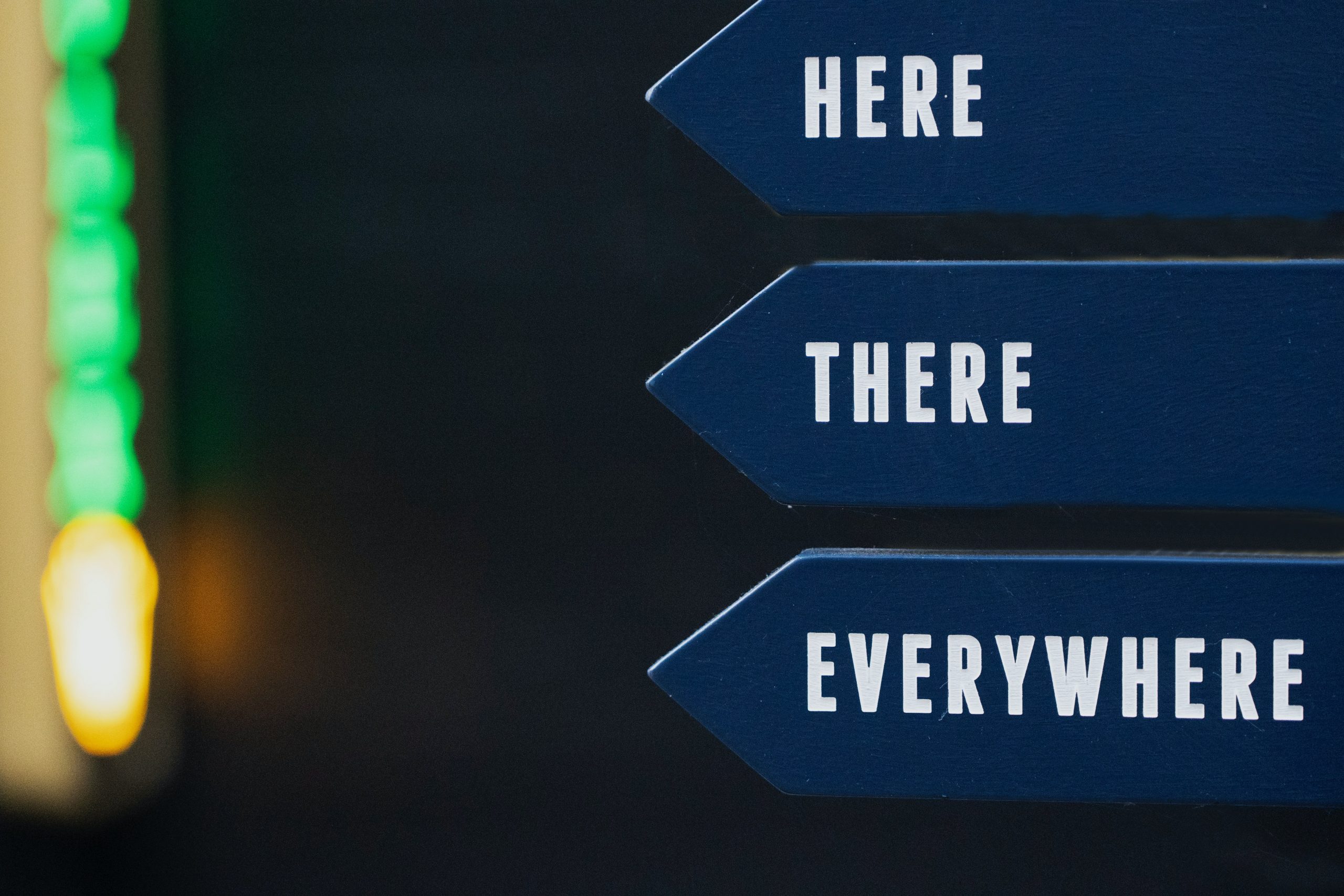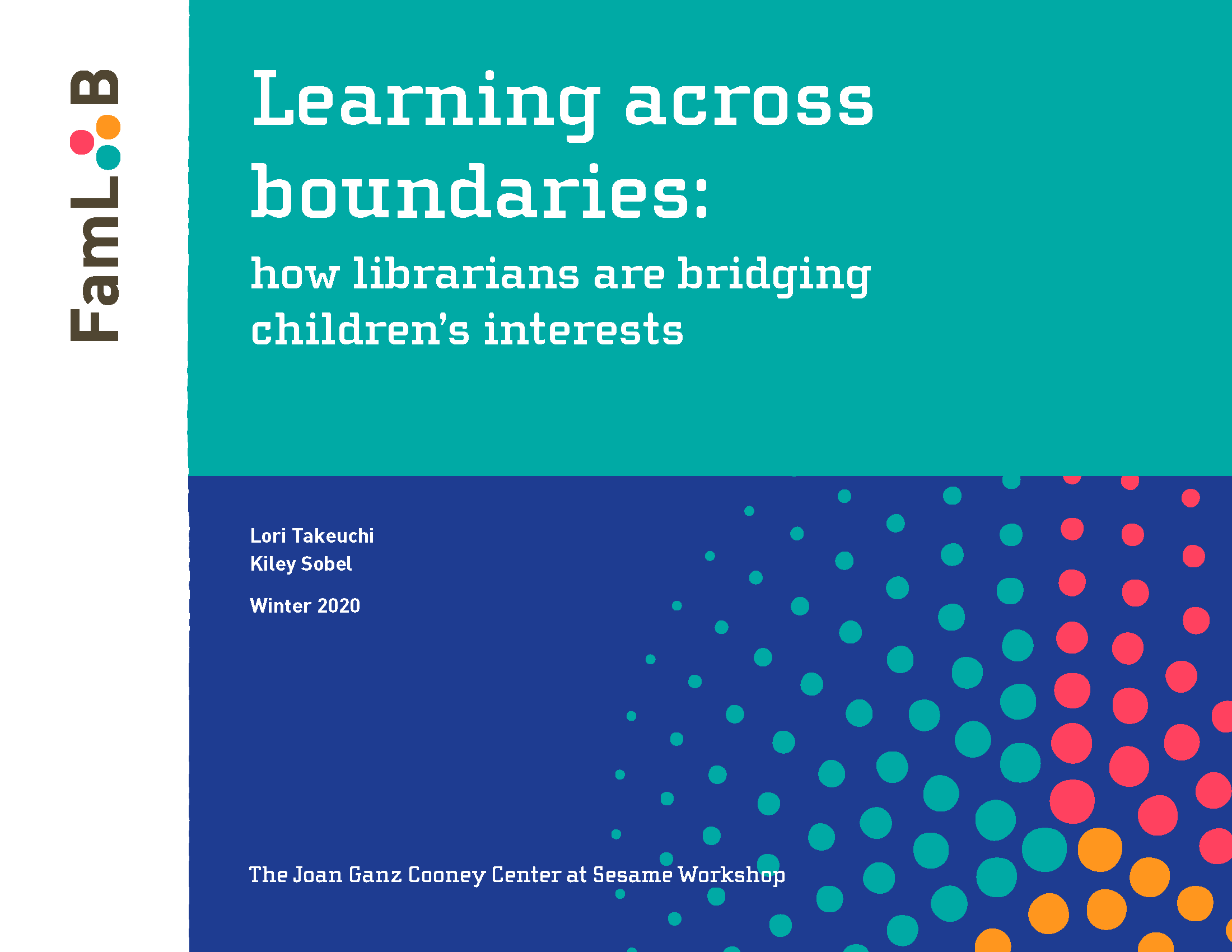In March 2020, schools, libraries, and businesses all over the country closed their physical buildings as we began the long effort to combat the COVID-19 pandemic. But community leaders rallied to bring their services to children and families at home, adapting to new circumstances with new technologies. Claudia Haines shares how the Homer Public Library transitioned from in-person to remote programs to keep families engaged throughout the pandemic.
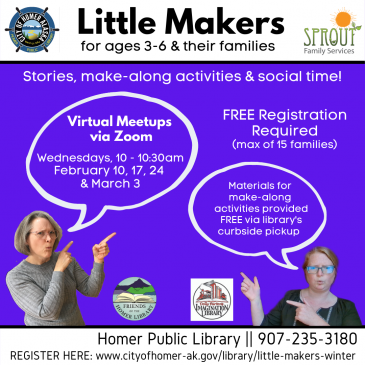 Just about a year ago, my library closed the building because of the COVID-19 pandemic. Here is the story of a program I co-designed with a colleague at a local early childhood organization to support families in our community from a distance. There have been a lot of tears, frustration, and even anger during the last year, but this program has been a triumph. It represents the many community partnerships I’ve been part of in the past year—with both organizations and individuals—and reflects the library’s place in a web of organizations and institutions that support families.
Just about a year ago, my library closed the building because of the COVID-19 pandemic. Here is the story of a program I co-designed with a colleague at a local early childhood organization to support families in our community from a distance. There have been a lot of tears, frustration, and even anger during the last year, but this program has been a triumph. It represents the many community partnerships I’ve been part of in the past year—with both organizations and individuals—and reflects the library’s place in a web of organizations and institutions that support families.
The virtual Little Makers program for 3-6-year-olds premiered in the Fall of 2020 as an experiment and we will be hosting our third iteration of it, Little Makers Spring Edition, in the coming weeks. Families were and are eager for learning experiences hosted by our two organizations and we are happy to connect with families.
Our shared goals for the program:
- support early learning
- introduce key media literacy and computational thinking concepts and skills
- foster family engagement
- maintain and even grow families’ relationship with the library and the community partner
Platform
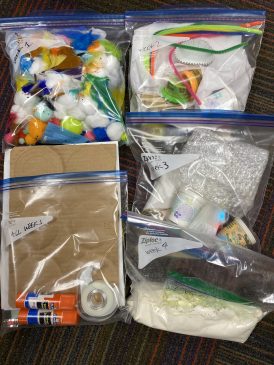
Zoom was the obvious choice for our needs, especially considering our weather here in Alaska between September and May. When we launched the idea of a virtual Little Makers on Zoom, enough time had passed during the hunker down period that many families were well-versed in using Zoom, or at least familiar with the idea of using videoconferencing for everyday meetups. Families joined with laptops, tablets, and cell phones.
Materials
Before the series of meetups began, registered families picked up a kit of materials funded by our Friends group and other Foundation support. I applied what I had learned from my summer experiment with Activity to Go! kits and included almost everything a family would need for the program – supplies and supporting information – organized and labeled for each of the four weeks. We didn’t assume families had glue sticks, for example. This way families could pull out a bag just before each week and be ready to go. For example, one week in the Winter session, we read Big Bed for Little Snow by Grace Lin. We then made a comfortable bed for Little Snow- one that wouldn’t burst – from materials including a paper plate, white and blue tissue paper, a coffee filter, pom poms, feathers, tape, and a tape measure. Some kids decided the bed was for a stuffy they had at home and found the tape measure especially useful for making sure the bed was the right size.
We included suggestions about how to make the virtual experience a successful learning experience in the supporting information, as well as details about the books we would share and prompts for making. (The image above shows what materials were included in each families’ kit for the Winter session). In the event that a family missed a week, or needed to leave early for whatever reason, families could make it at home with the information and supplies provided.
Timeline
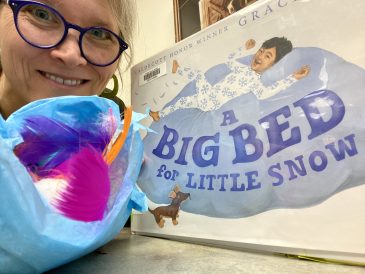
The routine for each of the four meetups in each session looked very similar so kids and families knew what to expect. We met for 30 min each week which was just the right amount of time. Kids were engaged and excited for the next week.
Welcome (2-3 minutes): We provided tech reminders as families entered the meetup from the waiting room including “Change your screen name to your child(ren)’s name” so we can call kids by name and “Before Claudia begins reading, we’ll ask you to mute your audio so everyone can concentrate on the story.” (This reduced at least some of the distractions we all experience.)
We also made time for hellos, calling kids by name, and introducing ourselves to make sure everyone knew our names.
Opening song (1 minute): “If You’re Ready for a Story” (This is the same song I sing on my weekly Radio Storytime program.)
Story (10-12 minutes): Each week I read one picture book and included one early learning, computational thinking or media literacy tip for grownups. As I read, I asked questions that kids could answer with a thumbs up, a nod or head shake, or a smile. These questions took into consideration the Zoom platform and the need to have audio muted for this portion of the program, but encourage engagement. I also asked questions with slightly longer pauses than you might expect, leaving space for caregivers to repeat the question at home and discuss with their little makers or siblings could talk about together. This was done in a way that didn’t disrupt the flow of the story.
Note on reading stories on Zoom: During the first meetup, I tried sharing a story using an iPad as a document camera connected separately to the meetup. For those on a mobile device, it was hard for them to see both my face and the book pages. With all of the different device types, different comfort levels with Zoom, and some people having updated versions of Zoom and some not, it worked more smoothly to share the book on my computer only with the pages close up to the camera while I read the text and then moving my face into the view when I was asking questions about the story, observing the illustrations, etc.
Making time (10-12 minutes): This part of the program was similar to the second half of preschool storytime in the library before the pandemic. The activity aims to help the little makers explore ideas in the book we shared, practice vocabulary that might be new to them as they play with the materials, and express their creativity. We invited grownups to turn on their video if it was off, change their Zoom view to “gallery” and turn on audio so we could all see and talk with each other for the remainder of the program. We then invited little makers to open their bag of materials as we announced the week’s creative prompt. The prompt presented a “problem” and families used the provided materials to make something that helped solve that problem. One week it was a bed for Little Snow. During a later session, we used ingredients similar to those found in the book Fry Bread: A Native American Family Story by Kevin Noble Maillard and Juana Martinez-Neal to make edible, no-bake play dough. Some of the materials from one week’s bag could be incorporated into another week’s making. This models repurposing and encourages creativity in problem-solving.
Regardless of the activity, we encouraged families to incorporate materials they had at home into the project. To get their creative juices flowing from the start, we played games like a color scavenger hunt in the first meetup (find something yellow like the colors of both Claudia and Red’s sweaters) or bring a stuffy to storytime today (and then make a fort or den for them in the activity portion of the meetup).
We also made sure to notice when families were doing something a little different and asked what they were up to and helped make connections to our activity if applicable. For example, while some of us were making fort prototypes with craft supplies after reading The Little Red Fort by Brenda Maier and Sonia Sanchez, one family made a fort out of couch cushions. The whole group talked about the fort as the family gave us a video tour and then we discussed where else we could build a fort – in the snow! We asked questions that encouraged the makers to tell us the fort’s story.
We anticipated that families would continue making beyond the time together on Zoom. We invited families to post pictures of their projects on a Padlet. Families could connect with each other and with us through the posts on the program-specific Padlet. We talked about the images during the following meetup. These photos were not shared on social media and the program was not recorded.
Closing (2-3 minutes): At the end of the meetup, we invited little makers to share and talk about what they were creating and what they might do next.
General Thoughts
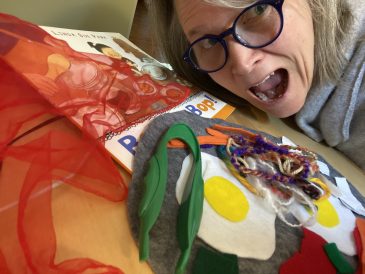
We slowed down the pace of reading, asking questions, and talking with families. What might be a normal pace for adults talking with others on Zoom or how we might talk in person, isn’t the same in this type of program. We keep in mind that families had different internet connection speeds which cause delays in what they see and hear, kids need a little time to get used to what they were seeing on the screen and young children often process and respond to information more slowly than adults.
We talk about the technology, the parts of the book, and the maker materials so that kids learn the names of things and what they can do. This is an important part of media literacy.
Fifteen families have registered for each session we’ve offered, the maximum we set. Within each session, there has been lots of variation in terms of who registered and almost all registered families have participated in every week. The number of families is determined by the funds we have for materials and a good size for the Zoom meetup. This group size allows us to have conversations with individual families within the allotted time.
We encouraged caregivers to play alongside their children and most households had a child or children attend alongside a grownup. But not in every case. And in some households, the caregiver never appeared in the screen. The prompts we designed took into consideration that an adult might not be right there.
It was very helpful to have two people on hand to share the facilitation roles and the tech troubleshooting, even if we were partners codesigning a program. While I am sharing the book, my partner was answering questions, welcoming families from the Zoom waiting room if they were late, and noticing if something was amiss. While she was introducing the maker activity, I was doing the same.
Two Lessons We Live by in This Program
- If something isn’t working as well as we’d hoped, we change it.
- We keep it as simple as we can while being creative.
This post was originally published on Never Shushed and appears here with permission.
 Claudia Haines leads storytimes, hosts Maker programs, and gets great media into the hands of kids and teens as the Youth Services Librarian and Media Mentor at the Homer Public Library (Alaska). She is a co-author of the Association for Library Service to Children’s white paper, Media Mentorship in Libraries Serving Youth (2015). She trains other librarians as media mentors and serves on both local and national committees that support families and literacy. She blogs at www.nevershushed.com. @claudiahaines
Claudia Haines leads storytimes, hosts Maker programs, and gets great media into the hands of kids and teens as the Youth Services Librarian and Media Mentor at the Homer Public Library (Alaska). She is a co-author of the Association for Library Service to Children’s white paper, Media Mentorship in Libraries Serving Youth (2015). She trains other librarians as media mentors and serves on both local and national committees that support families and literacy. She blogs at www.nevershushed.com. @claudiahaines
